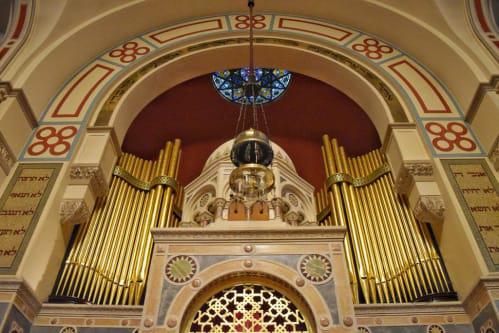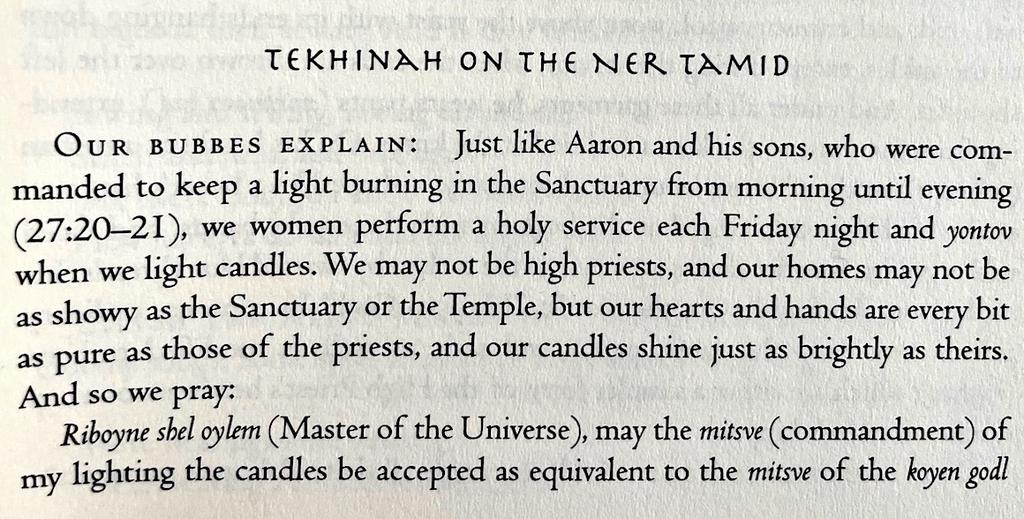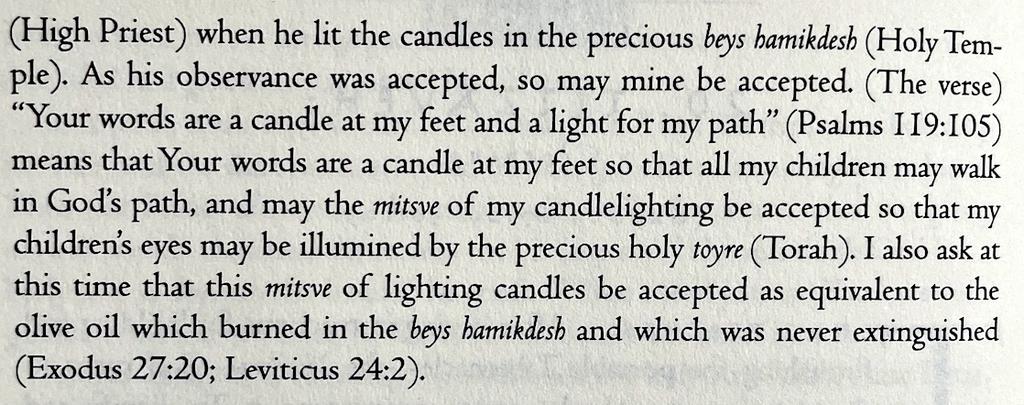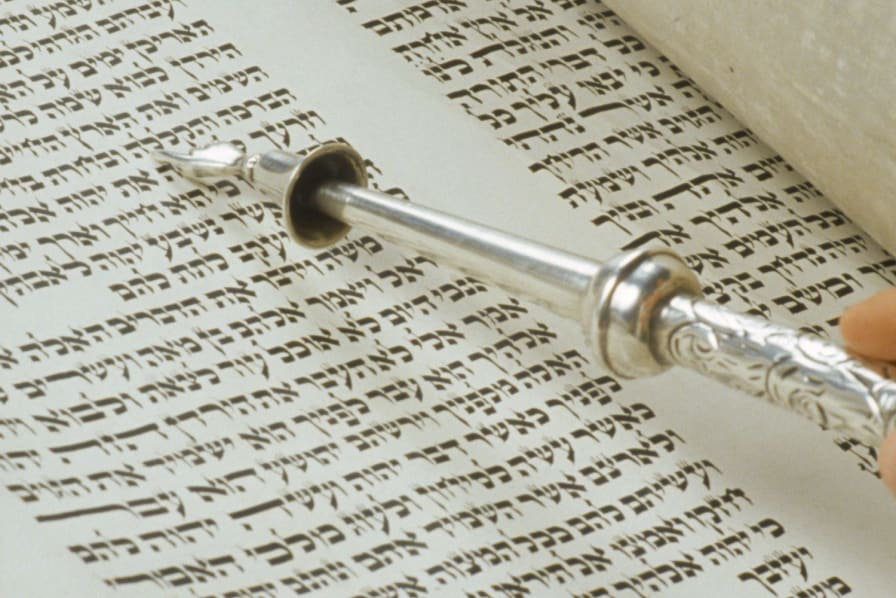20] You shall further instruct the Israelites to bring you clear oil of beaten olives for lighting, for kindling lamps regularly. 21] Aaron and his sons shall set them up in the Tent of Meeting, outside the curtain which is over [the Ark of] the Pact, [to burn] from evening to morning before יהוה. It shall be a due from the Israelites for all time, throughout the ages.
תמיד CONTINUALLY — doing something every night, as is described here, may be termed תמיד, continually, just as you speak of (Numbers 27:6) “The continual (תמיד) burnt-offering”, although this was sacrificed only from day to day. So, too, in the case of the meal-offering made in a flat pan it is said, (Leviticus 6:13) that it should be brought continually (תמיד) and yet it was only brought thus: “Half of it in the morning, and half of it at evening”. However, the expression תמיד which is used in connection with the show-bread (Exodus 25:30) denotes from Sabbath to Sabbath.
תמיד שלא תשאר המנורה בלא נר, או יאמר נר שהוא תמידי, וירמוז לנר מערבי שהוא עקר כל הנרות שכל הנרות פונות כנגדו והוא היה פונה כלפי שכינה שהיא המדה העשירית וזהו לשון תמיד, והבן זה. ובמדרש להעלות נר תמיד, זהו שאמר הכתוב (איוב י״ד:ט״ו) תקרא ואנכי אענך למעשה ידיך תכסוף אתה סובל את כל העולם כולו שנאמר (ישעיהו מ״ו:ד׳) אני עשיתי ואני אשא ואני אסבול ואמלט, ואתה מצוה לבני קהת להיות נושאים ארון כבודך על הכתף שנאמר (במדבר ז׳:ט׳) ולבני קהת לא נתן כי עבודת הקדש עליהם בכתף ישאו, אתה זן את כל העולם ואתה מצוה (במדבר כ״ח:ב׳) את קרבני לחמי אתה מאיר לכל העולם ואתה מצוה להעלות נר תמיד הוי אומר (איוב י״ד:ט״ו) למעשה ידיך תכסוף, ואמר הקב"ה לא שאני צריך לאור בשר ודם שבאורי אני מאיר לכל העולם אלא כדי להעלות אתכם ולזכות אתכם... ויהיה רמז לחנוכה של נרות חשמונאי ואם כן כשאמר יערוך אותו אהרן ובניו ירמוז לשעה ולדורות.
Tamid - that the Menorah should never be left without a light. Or the Torah is saying that the light should be eternal, and it's hinting at the 'western light', the essence of the others, for all the others were facing towards it, and it was facing towards the Presence of God, the tenth aspect of God, and that is the language of 'Tamid' - understand this!
A Midrashic approach (based on Tanchuma Tetzaveh 2): the words are reminiscent of Job 14,15: “You would call and I would answer You; You would yearn for (the deeds of) Your handiwork;” for it is written (Isaiah 46,4) “I was the Maker, and I will be the Bearer; and I will carry and rescue you.” Moses is to command the sons of Kehat to carry the furnishings of the Tabernacle on their shoulders as we have read in Numbers 7,9. The service of these Levites reflects a response to what God had done for the Jewish people. Similarly, You feed the whole world, so You command “My offering, My bread,” You make light for the entire universe, so You command to "kindle laps eternally" This is what Job meant when he described God as: “yearning for your deeds.”
God responded: “It's not that I need the light of flesh and blood, for through my light I illuminate the universe. Rather it's for you to elevate yourselves and to acquire merits.”...
This is also a hint to Chanukah and the lights of the Hasmoneans, and if so when it says "Aaron and his sons shall set them up" is a hint for this moment and for future generations.

by Rabbi Sylvia Rothschild 2015
The great medieval commentator Rashi asks about the unusual verb that is used – Le’ha’alot Ner Tamid, and says “one should deal with the flame and tend it so that it rises on its own” So Aaron would not actually have to relight the Ner Tamid, he would have to nurture it (trimming the wick or adding the oil) until the flame rose on its own. So this instruction to Aaron about the raising of the light of the Ner Tamid is nothing to do with illumination or lighting the lamp, it is about the nurturing of an existing flame, about the daily renewal of something profoundly important.
The Ner Tamid symbolises the eternal nature of our covenant with God – the real relationship that is always present – if not always acknowledged – between us and God. And just as the Ner Tamid needs regular and frequent tending, so does our relationship with God need regular and frequent attention if it is to be at its best...
The purpose of our covenant with God is to work to bring more light into the world, to make the world a better place by collaborating with the creator to bring about justice and righteousness in our world. If we see a Ner Tamid simply as a beautiful artefact hanging in a frequently empty building, then we miss the point that it is making – that each of us must make a daily effort to enlighten and improve our world.

CCAR Responsa
Is it actually required by Jewish legal tradition that there be an eternal light in front of the ark? Would it be a serious violation if the light is extinguished when, let us say, it is necessary to change gas pipes or electrical connections? (From Vigdor Kavaler, Rodef Shalom Temple, Pittsburgh, Pennsylvania.)
THE Eternal Light (ner tamid) is one of the most beloved symbols of the synagogue. When a synagogue is dedicated in modern times, one of the most impressive ceremonials is the first lighting of the Eternal Light. Since the use of an Eternal Light in the synagogue is based upon the Eternal Light commanded by God of Moses for the Tabernacle (Exodus 27:20 and Leviticus 24:2), one would imagine that this beloved symbol, with such ancient roots, would continually come up for discussion in the long sequence of Jewish legal literature. Yet the astonishing fact is that it is not mentioned at all as part of the synagogue appurtenances in any of the historic codes, the Mishnah, the Talmud, the Shulchan Aruch, or the others. One might say there is not a single classic mention of it (as far as I can find).
All the references that are usually cited as referring to an Eternal Light actually refer to an occasional light in the synagogue or else, more generally, to lights lit all over the synagogue during services, but not specifically in front of the Ark... However a clear reference is found in the eighteenth century. Jedidiah Samuel Tarika in his RESPONSA Ben Jedid, Chapter 7, in discussing a church lamp says of it, “It is just like ours which we hang before the Ark and which we call ‘eternal’ (t’midim). ”
Actually the earliest definite reference that I have come across is in the Talmudic encyclopedia, Pachad Yitzchok, by Isaac Lamperonti, Rabbi of Ferrara, seventeenth- eighteenth century. Ismar Elbogen, in his Gottesdienst, p. 476, says that the first literary mention of the synagogue ner tamid is in the seventeenth century. He may be referring to this citation in Pachad Yitzchok, which actually uses the expression “ner tamid” for the Eternal Light in the synagogue. None of Elbogen’s reference notes indicate that he saw an earlier mention than this one. Also Krauss (Synagogale Altertuemer, p. 391, Note 3) who discusses every detail of the appurtenances in the older synagogues, has made only this single reference (i.e., to Pachad Yitzchok).
This absence of any earlier reference to the synagogue Eternal Light is all the more remarkable because the general subject of lights in the synagogue is frequently discussed, from the time of the Tosefta through the Talmud, the Gaonim, and the later legalists. These discussions deal with the donation of lights and lamps to the synagogue (Tosefta Megilla III :3 and b. Arachin 6b) and whether these gifts may be changed for other purposes more needful to the synagogue at the time. Other discussions are on the question of whether a person may study by the light of the synagogue candles or lamps on the Sabbath, since it is generally prohibited to use the Sabbath lights for study, lest the person tilt them to improve the oil flow (b. Shabbas 12a)...
Of course, it is conceivable that although an Eternal Light may have been used in the synagogue right from the beginning, it just happens that no question ever arose about it. This is hardly believable because the various problems constantly discussed in reference to synagogue lights could very well have arisen with regard to the Eternal Light, had it actually been in general use. Clearly, it must have become an honored symbol only in recent centuries.
Because of this complete absence of earlier and classical reference to the synagogue Eternal Light in the legal literature, J. Wiesner (in Ben Chananiah, III, p. 581) surmises that it was borrowed from the use of an eternal light in Christian churches. But Wiesner is rather extreme in these matters. Leopold Loew, the editor of the magazine Ben Chananiah adds a note saying, “Why not say that the Jews derived it from the ner tamid in the Tabernacle and the Ancient Temple?” It well may be, therefore, that when the Eternal Light became customary a few centuries ago, it was seen to be analogous to the Eternal Light mentioned in the Bible for Tabernacle and Temple.
Be that as it may, the synagogue Eternal Light certainly has been in use for three centuries, and that is long enough for it to have become a beloved symbol. Evidently, its association with the biblically ordained Eternal Light for Tabernacle and Temple gave this symbol of the synagogue (whenever it did arise) an immediate and now a continuous sanctity. Therefore, to answer the question as to how uninterruptedly it must burn, we must consider it by analogy with the Eternal Light of the Tabernacle and Temple, with which it has now been for centuries associated.
How eternal was the original Tabernacle-Temple Eternal Light meant to be? Was it to burn without any interruption at all? We know that the fire on the altar is described as “not to be extinguished” (Leviticus 6:5). But the two biblical references to the Eternal Light, ner tamid, do not say that it is not to be extinguished. It is quite possible that the word tamid here does not mean “eternal,” but “regular.” In other words, the lights were to be kindled every day, but not necessarily to burn all of the day, so that one day’s light should continue into the next, uninterrupted. In fact, Rashi to the passage in Exodus simply says that “tamid” here means “every night.” Rashi’s statement is an epitome of his argument in b. Hagiga 26b. The Tosfos there partially disagrees with Rashi and says that one of the two Tabernacle and Temple lights did miraculously stay alight permanently. The Talmud also (in Tamid 30b) describes how the lamps were cleaned every day at dusk. The priest cleaned every one except one which remained alight until the others were cleaned and rekindled. This one light was called “the western light,” and it is presumed that our single, eternal light is derived from (or is analogous to) this.
At all events, Isaac Lamperonti, in the first reference which I have found to ner tamid, used in the synagogue (s.v., ner tamid) says that since Rashi has explained that “tamid” in relation to the Tabernacle and Temple Light did not mean “continuous,” but “regular,” therefore we must conclude from Rashi that the ner tamid which we now have in the synagogue, which is to us “the small sanctuary,” need not burn at all except at the hour of prayer. (The phrase, “the small sanctuary,” for the synagogue, comes from b. Megilla 29a, based upon Ezekiel 11:16.) Here we have then, a clear statement that the light may even be extinguished.
But, of course, we must bear in mind that two centuries ago they had only oil lamps or tallow candles, and to keep a light continuous would be a difficult task. This may be an additional reason for assuming that they never had an Eternal Light in the synagogue in the past, namely, the technical difficulty involved. At all events, nowadays, with gas or electricity, it is easily possible to have the Eternal Light actually continuous, except for some accident. In that case, it should certainly be maintained as such. But should it be necessary, for purposes of rewiring or pipe refitting, to extinguish it, then there is no actual violation of the law involved at all. It is for us to maintain the general ideal of an eternally burning light, but we must remember that the authorities doubt whether even the original light in the Tabernacle and Temple itself was actually meant “never to be extinguished.”






